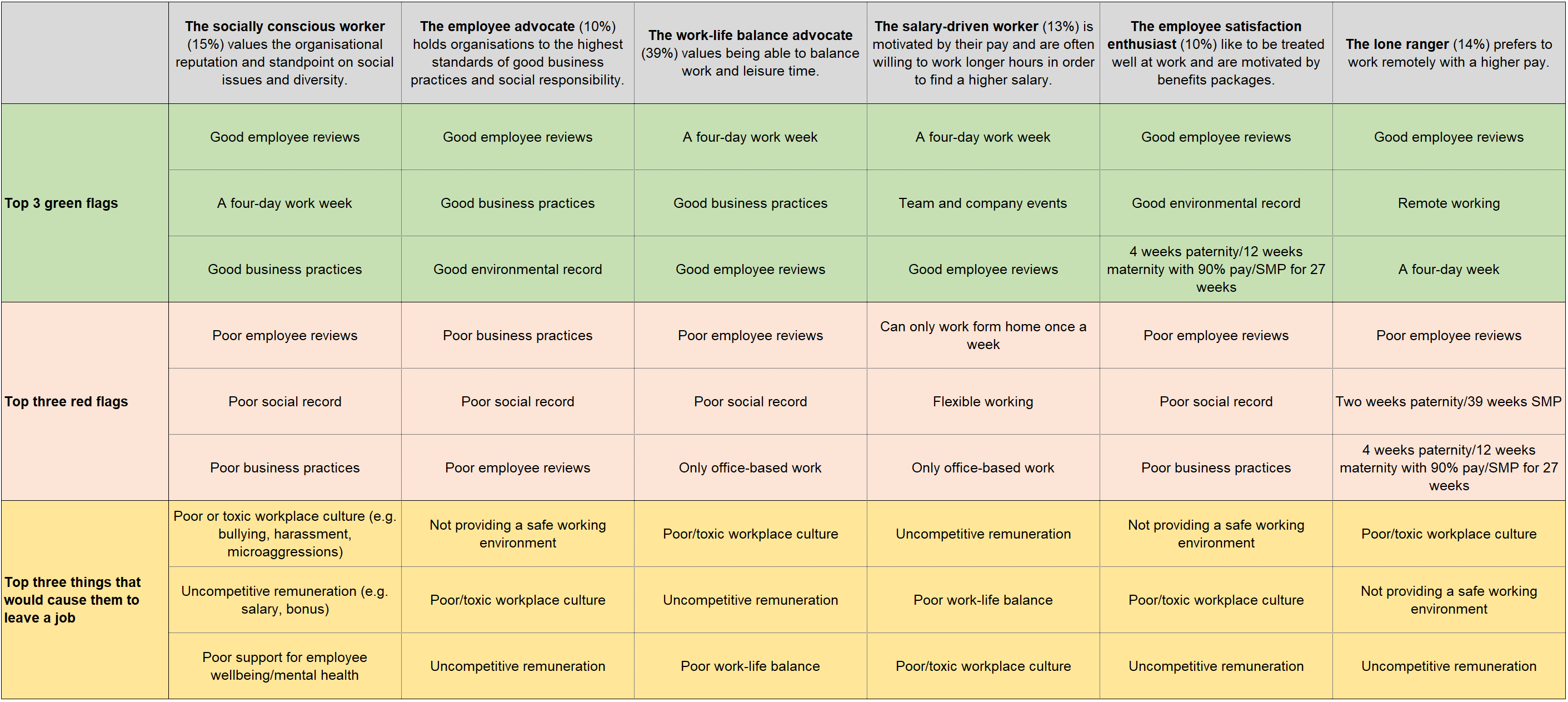Omniployment Era – What does this mean for Managers?
With retention a problem and the flexible/hybrid/at work debate ongoing, a recent study by Henley Business School was a fascinating read.
Their study involved 3,000 UK employees and comprised a mixed method approach. It included interviews and surveys to understand red and green flags when looking for work, why people apply for jobs and what causes them to leave.
Through this research they identified six profiles and associated factors that would raise either flag when job hunting and the top tipping points that would cause an individual to quit their current position. The result are displayed in the table below.

Ultimately the study hints at a move away from a one-size-fits-all view of management to what Henley Business School calls the ‘omniployment’ era – omni meaning ‘all’ or ‘every kind’ – it “encapsulates a broader, tailored approach to employment”. However, it raises an interesting question about how managers go about adapting their style.
Whilst the conclusion of the study is that management should be moving away from a one-size-fits-all approach it is clear from the study that there are three things that stand out as being crucial factors when it comes to attracting and retaining people:
- Reputation of the organisation ‘Good employee reviews’ is a common green flag across all profiles and, whilst it doesn’t show for all, ‘poor employee reviews’ is one of the two top-ranking red flags across most of the profiles. The other being ‘poor business practices’ which can also damage the reputation of a business – so establishing and promoting good business practices is a positive move in attracting and retaining staff.
- Flexible working provision ‘a four-day week’ rates as a reoccurring green flag and red flags include ‘only office-based work’ and ‘can only work from home once a week’ so this is clearly a major consideration for those looking for work and in retaining existing workers.
- Benefits and wellbeing considerations team building, medical insurance and maternity/paternity pay are considered important traditional benefits whilst ‘a poor or toxic workplace culture’ featured across the board as a thing that would cause someone to leave their job – along with ‘uncompetitive remuneration’.
However, there are some things that are specific to certain profiles and these would need to be managed on an individual basis – thus ‘omniployment’. Firstly, understanding the distinct characteristics and preferences of each profile is essential. Managers can use the identified green flags for motivation and engagement, tailoring recognition and rewards accordingly. They can also acknowledge potential red flags and address associated factors, as this will be crucial in preventing dissatisfaction or turnover. Here are our thoughts on how to manage the different types of profiles:
1. The Socially Conscious Worker
Management Preference: Values the organisational reputation and standpoint on social issues and diversity.
Effective Management Approach: Align the work with meaningful goals and social responsibility. Provide opportunities for involvement in sustainability initiatives, communicate openly about the organisation’s impact, and foster a transparent, ethical and diverse work environment.
2. The Employee Advocate
Management Preference: Holds organisations to the highest standards of good business practices and social responsibility.
Effective Management Approach: Encourage open communication, address concerns promptly, and actively seek and implement feedback. Recognise and reward advocacy efforts and demonstrate a commitment to fair and inclusive workplace policies.
3. The Work-Life Balance Advocate
Management Preference: Values being able to balance work and leisure time.
Effective Management Approach: Offer flexible work arrangements, promote realistic workload expectations, and prioritise a culture that respects boundaries. Encourage time off when needed and create an environment where employees feel supported in maintaining a healthy work-life balance.
4. The Salary-Driven Worker
Management Preference: Motivated by their pay and are often willing to work longer hours in order to find a higher salary.
Effective Management Approach: Provide competitive compensation packages, clearly communicate opportunities for financial growth, and offer performance-based incentives. Recognise and reward achievements through bonuses or other financial incentives to maintain motivation.
5. The Employee Satisfaction Enthusiast
Management Preference: Likes to be treated well at work and are motivated by benefits packages.
Effective Management Approach: Create a positive work environment with opportunities for skill development and career growth. Acknowledge and appreciate contributions, encourage team-building activities, and actively seek and act upon feedback to enhance overall employee satisfaction.
6. The Lone Ranger
Management Preference: Prefers to work remotely with a higher pay.
Effective Management Approach: Provide autonomy and opportunities for self-directed work. Clearly communicate expectations, offer support when needed, and recognise individual achievements. Foster a culture that values and rewards independent contributions while ensuring the lone ranger feels connected to the team’s overall goals.
Henley Business College has three bits of key advice that they offer to organisations that are truly committed to improving their relationship with employees and effectively addressing their needs: “1. Embrace a workplace culture built around homogeneity, 2. Make working flexible and 3. Be transparent.”
Understanding and adapting management styles to accommodate the preferences of the different employee profiles can contribute to a more engaged, satisfied, and productive workforce. However, it’s crucial to recognise that individuals may exhibit characteristics from multiple profiles, and effective management involves a flexible and tailored approach.